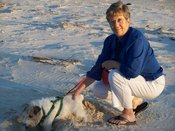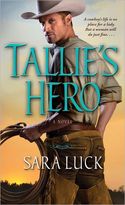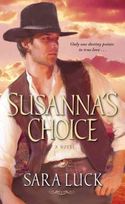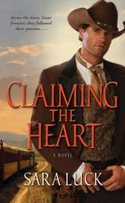
 I want to thank Fresh Fiction for the review of my latest book, TALLIE’S HERO. As a writer with only three books in print, I am flattered to be in the company of romance writers, whose work I have long enjoyed.
I want to thank Fresh Fiction for the review of my latest book, TALLIE’S HERO. As a writer with only three books in print, I am flattered to be in the company of romance writers, whose work I have long enjoyed.
For almost forty years I have lived with a writer, and I have come to accept that he goes into his office, sits down at the computer and within a couple of months he has another book done. Over the years I have started many books and I have even finished several of them, but when I look at my time frame I see five years for this one, three years for that one—well you get the picture. I have learned that writing on a deadline is hard work. Sometimes the bed doesn’t get made, or the clothes don’t make it to the drawer, or the plants get a little droopy. All that I can justify.
But now I have found another distraction—research.
The three books that I have on the market are all historical romance. They have been set in the West, but I can’t classify them as specifically Western. One reviewer has classified them as Americana, and I think I like that.
 SUSANNA’S CHOICE |
 CLAIMING THE HEART |
 TALLIE’S HERO |
I have discovered that I prefer to start with a setting and then build a story. The first book I wrote, SUSANNA’S CHOICE, was set in Virginia City, Nevada, during the days of the Comstock Lode. I bought a series of books kept by a newspaper editor, called THE JOURNALS OF ALFRED DOTIN 1849-1903. I bought them for my husband, and I have to say I paid more money for them than I want to admit. I kept browbeating him to use these fabulous books that provided a day by day chronicle of the life of one man for 54 years. Finally, he turned to me and said, “If you think they‘re so great, you write a book.”
Now that was a challenge.
I did write a book, and I have to admit that without the support of my wonderful husband and his agent, that book probably would have joined the others tucked away on the shelf. Nobody was more surprised than I, when Simon and Schuster gave me a contract for two books. And with a deadline! Not five years or three years or even one year, but four months to get another book written.
I couldn’t write another story about Virginia City, so I turned to my husband’s bookshelves and found a series of books called HISTORY OF TEXAS; FORT WORTH AND THE TEXAS NORTHWEST EDITION by B.B. PADDOCK, publication date 1922. Buckley Paddock was also an editor of a newspaper, the Fort Worth Democrat. Maybe I could find a kernel somewhere in those four volumes that would be the genesis of an idea for a story.
And I did find it. CLAIMING THE HEART is the story of the true spirit of community that the people of Fort Worth displayed when they formed “The Tarrant County Construction Company,” and determined that they, the people, would bring the Texas and Pacific Railroad into their city. Except for the obvious fictional characters, all the participants are real. And then I found names that are a part of the North Texas landscape—Throckmorton and Forney and Courtright and Daggett and Van Zandt and John Peter Smith—and I wanted to find out why the towns, streets and buildings were named after these people, so that meant more research and more characters.
But my favorite discovery was a woman named Victoria Woodhull who was on a speaking tour of the South. I had to know who she was, because I had never heard of her. And now I know. I read three books about her. She was the first woman stockbroker in the United States, she ran for president in 1872 with Frederic Douglas as her running mate, and she went around the country giving speeches about “free love.”
Free love? What did that mean in 1876? I was writing a romance novel about the T & P Railroad coming to Fort Worth, but I had to find a way to put this fascinating woman into the story. So my hero, an Easterner, had known her before he came to Texas.

TALLIE’S HERO is my third book.
When our children were small our family visited Jerome, Arizona, a fascinating town, described as the largest ghost town in America. It’s not quite a ghost town now, as a few enterprising people have moved in to do business with the tourists. Jerome was named for Winston Churchill’s mother, Jennie Jerome Churchill—or so my husband told me. But I found out that wasn’t true. It was named for a cousin of Jennie Jerome’s who invested money in the town, but never once set foot in it. Not a very fascinating story.
But if there was no story in the town of Jerome, there was definitely a story in Jennie Churchill. The research about her, and her multiple love interests, led me to the Marlborough set and the shenanigans of HRH Albert-Edward, Prince of Wales.
But this was to be a story about the West, not Victorian England. How could I incorporate all this titillating stuff into a romance set in the West?
Then I read about Ouida, a passionate Victorian author, and I knew I had found the key. Ouida became the prototype for my heroine, Tallie Somerset. In the story, Tallie is an English author, who is a friend of Jennie Churchill. She writes about the Prince of Wales, to the great displeasure of Queen Victoria.
I didn’t know where Tallie would live, so I picked out a spot on a map of England. Then I thought I’d better find out something about the town I had chosen. The first thing I read was that Down, Kent, was the home of Charles Darwin, so now I had to read two or three books about the life of Charles Darwin and his wife Emma, and they became Tallie’s friends. All this stuff fascinated me, but Tallie was still in England. How would I get her to America and the West?
Enter Moreton Frewen. What a fascinating character he was. I found his autobiography called MELTON MOWBRAY AND OTHER MEMORIES, so I ordered it from England. In the book, Frewen is quite candid about his ill-fated business adventures. His ranch in the Powder River country of the Wyoming Territory in the days when cattle had free range was one such venture. Frewen married Clara Jerome, Jennie Churchill’s sister, and Jennie asked her friend, Tallie, to go to America to attend the wedding. Here was the connection to the West that I needed. I had a story.
As I researched Moreton Frewen, I read about all the dukes and earls who had come to the Big Horn Mountains on hunting expeditions, and how Moreton and his brother alienated all the neighbors.
My hero, Jeb Tuhill, had to be the good guy in all of this, but how would I connect him?
In MELTON MOWBRAY, I had read about John Adair, owner of a large estate in Ireland where Frewen frequently rode to hounds. His first trip to America had been with Adair when he went to the JA Ranch in Texas to meet Adair’s partner, Charles Goodnight. This was my ah ha moment. Jeb Tuhill would be a cattleman from Texas whom Moreton Frewen enlists as a partner, not only to help with his cattle operation in Wyoming, but to go to England to help raise money from investors where he meets—Tallie Somerset.
When I had all these historical connections figured out, then I knew I could write a story. All I had to do was bring Jeb and Tallie together, and imagine how they would react to one another.
I truly love it when all the little tidbits of history can work into my stories, and I hope that I am telling stories that are not only entertaining, but truthfully told.
Tell us about your love of places or histories to win a copy of each of Sara’s books!
To comment on Sara Luck’s blog please click here.


No Comments
Comments are closed.